
Manufacturer's Specifications:
Speeds: 1 7/8 and 3 3/4 ips.
Wow & Flutter: 0.06% at 3 3/4 ips, 0.10% at 1 7/8 ips.
Frequency Response: 20 Hz to 24 kHz at 3 3/4 ips, 20 Hz to 18 kHz at 1 7/8 ips with CrO2 tape, 20 Hz to 20 kHz with metal tape.
S/N: At 1 7/8 ips, 67 to 69 dB with Dolby B NR, 74 to 76 dB with Dolby C NR; at 3 3/4 ips, 69 to 71 dB with Dolby B NR, 76 to 78 dB with Dolby C NR.
Dimensions: 19 in. (48.26 cm) W x 13 in. (33.02 cm) D x 4 in. (10.16 cm) H.
Price: $700.00.
Dual's new C844 cassette deck is one of the few models available currently to have the 3 3/4 ips speed option, and it also offers a number of other features, such as both Dolby B and C noise reduction, a monitor head, a fade/edit control, a six-position tape selector, a Music Finder system, an electronic digital counter, and provision for microphone mixing.
The C844 is a sleek, modern low-profile design with the tape compartment on the left and tape-transport controls to the right, on the main panel. In addition to the usual recording and directional controls are additional pushbuttons marked Autospace, Repeat, and Double Speed. The Auto space control creates a blank space at the end of a recorded section which is used by the Music Finder to stop the tape. Underneath these pushbuttons is the six-position tape selector, the Dolby switch (C, Off, and B), the MPX switch, and the tape monitor. The dual-concentric line input control is to the right with the microphone input sockets and the microphone input control. Above the microphone sockets are three fade/edit switches. The first switches the circuit on, the second fades out the signal, and the third fades in the signal. The system works only during playback, to monitor the fade action on recorded tapes. I wish it worked on record too, such as for dubbing. A long dial at the top contains the large VU meters, peak-reading indicators, electronic digital counter, and memory switch while over to the left, on the other side of the cassette compartment, is the on/off switch, phone jack, and timer switch.
The peak-reading indicators are a little unusual in that they are connected to the equalization circuit so that the characteristics are "tailored" to the kind of tape used. More about that later, but for now some details about the Music Finder system. Both fast-wind buttons are marked Music Finder, and if one is depressed after the Stop button is activated, the tape is wound back in that direction to the end of the tape. If either is depressed after the Repeat button is pushed, the tape is wound to the first music gap reached, and automatically switched to the playback mode.
If either is pressed after Record, the tape will stop after reaching the first gap. The gap can be made deliberately, as mentioned earlier, or it can be the normal gap between bands on a disc.
When the Record button is depressed, a red light appears above it, and a flashing green indicator lights up near the Repeat button. After the levels have been set, the Repeat button is depressed to start the recording process, and the flashing stops. It is thus unnecessary to use the Pause control for initial adjustments. If a speed change is made during operation, the tape stops completely for a few seconds before starting again at the required speed.
The cassette compartment has no door, since a direct loading method is employed. The Dual infrared system automatically stops the drive motor and retracts the heads as soon as a hand is placed near the cassette for withdrawal. There are two drive motors, one for the reels and one for the capstan, and provision has been made for remote control with a DIN-type connecting socket on the back panel.
Measurements
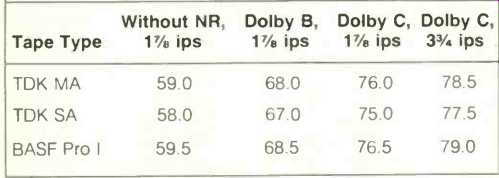
Table I--Signal-to-noise ratios, dB, A weighted, ref. to 3% THD.
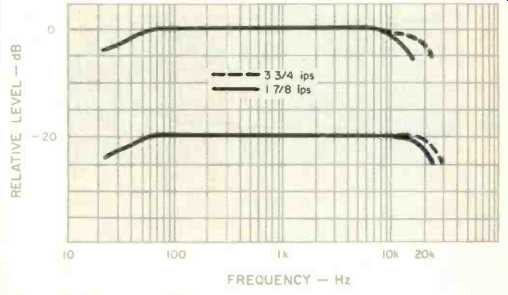
Fig. 1--Playback response with a standard test tape.
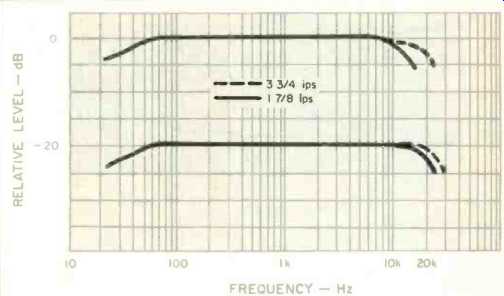
Fig. 2--Record-replay response with TDK MA metal tape.
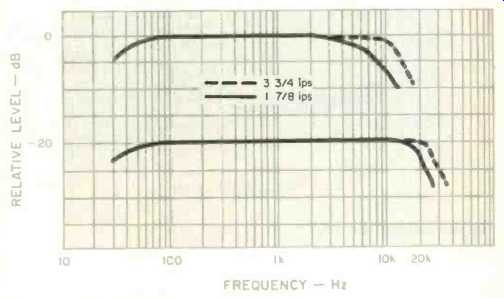
Fig. 3--Record-replay response with TDK SA tape.
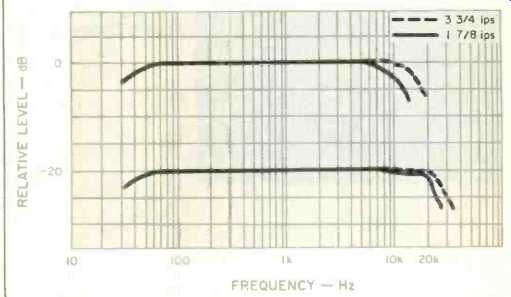
Fig. 4--Record-replay response with BASF Professional I tape.
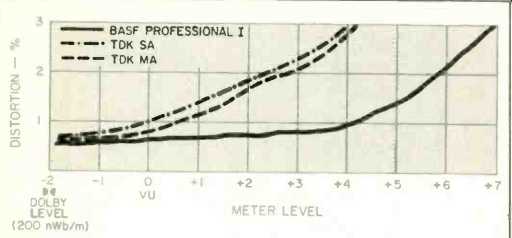
Fig. 5--Distortion and headroom at 1 kHz.
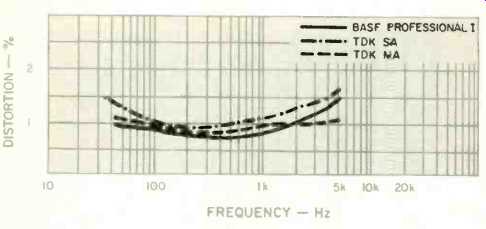
Fig. 6--Distortion vs. frequency, 0 VU.
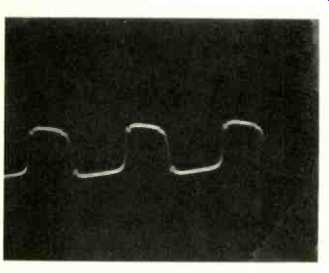
Fig. 7--Square-wave response at 1 kHz, 3 3/4 ips, with Dolby C NR.
Playback response was within 1 dB from 40 Hz to 12 kHz using a standard test tape (Fig. 1). The first test tape used for record-replay measurements was a TDK MA metal formulation, and results are shown in Fig. 2. At 0 VU, changing from the slow to the fast tape speed extended the-3 dB point from 16 to 21 kHz, and similarly added 3 kHz to the 23 kHz response at-20 dB. With the second tape tested, TDK's SA, a high-bias 70-µS formulation, the advantages of the fast speed were even more dramatic, as can be seen in Fig. 3. At 0 VU, the-3 dB frequency was moved from 7 to 13 kHz-quite a difference! At -20 dB, the -3 dB frequencies were 21 and 25 kHz. The third tape was a ferric 120-µS type, BASF Professional I, and here again the improvement with the 33/4 ips speed was particularly effective at 0 VU. At 17/e ips, the-3 dB frequency was 8.5 kHz, but at 33 ips it had increased to nearly 16 kHz! (See Fig. 4.) The response at -20 dB was quite similar to that of the TDK, with the exception of a very slight droop above 10 kHz.
Figure 5 shows the distortion and headroom at 0 VU, and Fig. 6 compares distortion for the three tapes from 40 Hz to 5 kHz for levels of 0 VU. Signal-to-noise figures can be seen in Table I; note that the fast speed increases the already high figures by 2.5 dB. Input required for 0 VU was 24.5 mV, and the output varied from 339 to 436 mV, depending on the kind of tape used. Microphone sensitivity was 0.5 mV, with a maximum handling capacity of 177 mV, which provided a better than average margin against overload. Both Dolby B and C systems tracked down to -40 dB within 1.5 dB with all three test tapes.
The six equalization positions on the C844 consist of two for 120-µS ferrics, two for high-bias chromium dioxides or similar 70-µS tapes, one for FeCr types, and one for metal particle formulations. In order to reflect the differences in high-frequency headroom, the four peak-reading LEDs are marked in percentages to indicate how much headroom is available on the particular tape used. Thus, the 75% indicator lights up at 0 VU with metal tape, 100% with FeCr, and so on. This is a most ingenious idea and also takes into account the effect of the Dolby C system. The VU meters had a slight overshoot with a standard ASA 300-mS, 1-kHz pulse, but the peak indicators were very accurate, and the manufacturer rightly says that the LED display is more important than the meters.
Erase efficiency was better than 70 dB, as claimed, while wow and flutter measured 0.03% at 1 7/8 ips and 0.02% at 3 3/4 ips-considerably better than the specifications. Rewind time for a C-90 was 150 seconds at 1 7/8 ips, and speed in both modes was less than 0.1% fast.
Encouraged by the quite remarkable frequency response, I thought I'd take a look at the square-wave performance, and the result can be seen in Fig. 7. Using TDK's MA metal tape and applying a 1-kHz square-wave signal, there was an absence of ringing together with a fast risetime-unusually good for a tape deck.
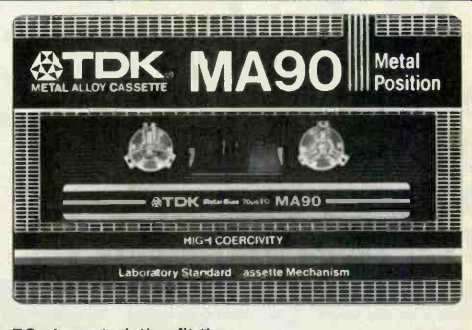
---- EQ characteristics fit the tape type used.
Use and Listening Tests
As the test figures show quite clearly, the C844 is a high quality cassette deck, probably a state-of-the-art design in terms of basic performance, and it compares favorably with some open-reel models. The logic controls all worked smoothly, with a professional feeling, and mode changes can be made without danger of tape strain or breakages.
The 3 3/4 ips speed, with its greater headroom, is definitely worthwhile for direct recordings made with first-class microphones (I used B & K 4134s) or for taping direct-to-disc recordings. For most purposes, the slower speed is perfectly adequate, especially if Dolby C NR is used. The Music Finder system will certainly appeal to some users, but I was more impressed with other features like the microphone mixing facility, the versatile tape selector, and the care taken to match the peak level indicators to the different tape characteristics. The electronic tape counter, with its large eye-catching green display, can be read from a considerable distance--a great improvement on the mechanical indicators that almost need a magnifying glass to read. The only criticisms I could possibly make relate to the fader controls (described earlier) and a personal preference for a variable output control.
-George W. Tillett
(Adapted from: Audio magazine, Jul. 1982)
Also see:
Dual Model C-939 Auto-Reverse Cassette Deck (Equipment Profile, Apr. 1978)
Dual C 820 Cassette Deck (Sept. 1980)
Fostex 250 Mixer/Recorder (Aug. 1982)
Bang & Olufsen Beocord 9000 Cassette Deck (July 1982)
= = = =